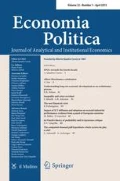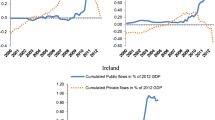Abstract
This paper explores the impact of the Economic and Monetary Union (EMU) and the ensuing financial integration on Euro Area (EA) macroeconomic imbalances. It is found that EMU caused an exceptional deterioration of current account positions in relatively unequal EA countries more than in the others. The explanation provided is that the large increase in money supply following the abolition of capital controls in 1990, of exchange rate risks in 1999 and the parallel softening of domestic credit market regulation throughout the 1990s that lead to downwards interest rate convergence had the effect of relaxing collateral constraints specifically for lower-income households, whose share is found to rise with levels of income inequality. Optimistic expectations about future income led to over-borrowing by these groups. Consequently, current account reversal was asymmetric because the crisis forced indebted lower-income (unskilled) households to abruptly reduce consumption, as they were the first to be pulled out of the labour market and hardly had financial buffers. The hypothesis is tested using a difference-in-difference approach to panel data.

Source: Own elaboration based on Ameco and Standardised World Income Inequality Database (SWIID). The sample includes all euro area countries that entered in the first wave (except Luxembourg) plus Greece

Source: Own elaboration based on AMECO Database, Penn World Tables and Standardised World Income Inequality Database. The sample includes all euro area countries that entered in the first wave (except Luxembourg) plus Greece

Source: Own elaboration based on Eurostat. The sample includes all euro area countries that entered in the first wave (except Luxembourg) plus Greece. Unequal includes Greece, Ireland, Italy, Portugal and Spain; equal consists of Austria, Belgium, Finland, France, Germany, and The Netherlands. The gross debt to income ratio is defined as debt arising from loans, recorded at the end of each calendar year, to the gross disposable income of the same year (Eurostat). The net financial assets to income ratio is defined as total financial assets minus liabilities at the end of each calendar year to the gross disposable income of the same year (Eurostat)

Source: Own elaboration based on Eurostat. The low-skilled employment rate is given by the employment rate of those with pre-primary and primary education (Eurostat). The sample includes all euro area countries that entered in the first wave (except Luxembourg) plus Greece. Unequal includes Greece, Ireland, Italy, Portugal and Spain; equal consists of Austria, Belgium, Finland, France, Germany, and The Netherlands

Source: Own elaboration based on Chinn and Ito (2006) and Fraser Institute. The sample includes all euro area countries that entered in the first wave (except Luxembourg) plus Greece. Unequal includes Greece, Ireland, Italy, Portugal and Spain; equal consists of Austria, Belgium, Finland, France, Germany, and The Netherlands
Similar content being viewed by others
Notes
It should be noted that the distinction between the competitiveness and the capital-flow hypothesis is a bit artificial here as the two explanations are not mutually exclusive. So, for example, criticism of the competitiveness hypothesis does not necessarily imply that differences in prices and wages do not play a role. Capital flows into the periphery lead to overheating and an acceleration in wage and price growth that ultimately hinges on competitiveness. Yet, the distinction between the two hypotheses allows better identifying the nature of the EMU shock, i.e. whether stemming from competitiveness divergences or rather from capital mobility and its consequences.
We use income inequality as a proxy of relative poverty. Figure A (in the “Appendix”) shows for each country the relation between a standard measure of income inequality such as the Gini coefficient and the share of the population that is considered at risk of poverty because her income is lower than 60 percent of the median disposable income, as in the definition used by the Eurostat (we use the year 2006 because this is the first year for which the Eurostat provides data for all European countries but France). Clearly, the two are interrelated. This is also because of the way in which relative poverty is defined, which makes it a statistic of income distribution. In the statistical analysis, we use the standardised Gini coefficient, which provides better coverage of both countries and time.
There is recent evidence showing that capital account openness causes income inequality both in the short- and medium-run (Furceri and Loungani 2015).
Interestingly, Hope (2016) uses a synthetic control method to prove that the introduction of EMU was responsible for the divergence in current account balances among member states in the run-up to the euro crisis.
We avoid offering a thorough theoretical account of sources of macroeconomic imbalances that would be unrelated to European monetary unification (e.g. twin-deficits hypothesis, demographics, etc.), but include them as control variables in the econometric exercise that follows.
See Footnote 4.
The erosion of net financial assets was probably also driven by highly volatile returns from financial investment.
The distinction coincides with that between core and periphery.
See list of variables in the “Appendix”.
The Chinn-Ito index accounts for the number of restrictions on cross-border financial transactions as reported in the IMF’s Annual Report on Exchange Rate Arrangements and Exchange Restrictions. Greater values indicate that a country is more open to cross-border financial transactions (Chinn and Ito 2006).
For a definition of variables and sources, see “Appendix”.
References
Abiad, A., Leigh, D., & Mody, A. (2007). International finance and income convergence: Europe is different, IMF Working Paper 64.
Al-Hussami, F., & Remesal, A. M. (2012). Current account imbalances and income inequality: Theory and evidence, Kiel Advanced Studies Working Papers 459. Kiel Institute for the World Economy.
Belke, A., & Dreger, C. H. (2013). Current account imbalances in the Euro area: catching up or competitiveness. Review of International Economics, 21(1), 6–17.
Blanchard, O., & Giavazzi, F. (2002). Current account deficits in the Euro Area: the end of the Feldstein-Horioka Puzzle? Brookings Papers on Economic Activity, 2, 147–186.
Carlin, W. (2013). Real exchange rate adjustment, wage-setting institutions, and fiscal stabilization policy: lessons of the eurozone’s first decade. CESifo Economic Studies, 59(3), 489–519.
Chinn, M., & Ito, H. (2006). What matter for financial development? Capital controls, institutions, and interactions. Journal of Development Economics, 81(1), 163–192.
Chinn, M., & Prasad, E. (2003). Medium-term determinants of current accounts in industrial and developing countries: an empirical exploration. Journal of International Economics, 59(1), 47–76.
Debelle, G., & Faruqee A. (1996). What determines the current account? A cross-sectional and panel approach, IMF Working Paper 58.
Eggertsson, G. B., & Krugman, P. (2012). Debt, deleveraging, and the liquidity trap: a Fisher–Minsky–Koo approach. Quarterly Journal of Economics, 127(3), 1469–1513.
Fagan, G., & Gaspar, V. (2007). Macroeconomic adjustment to monetary union, ECB Working paper 946.
Fagan, G., & Gaspar, V. (2007). Adjusting to the Euro, ECB Working Paper 716.
Furceri, D., & Loungani, P. (2015). Capital account integration and inequality, IMF Working Paper 243.
Gabrisch, H., & Staehr, K. (2015). The Euro Plus Pact: competitiveness and external capital flows in the EU countries. Journal of Common Market Studies, 53(3), 558–576.
Gaulier, G., & Vicard V. (2012). Current account imbalances in the euro area: competitiveness or demand shock? In Banque de France, Quarterly selection of articles, n. 27.
Giavazzi, F., & Spaventa, L. (2010). Why the current account may matter in a monetary union: Lessons from the financial crisis in the Euro area, CEPR Discussion Paper 8008.
Gros, D. (2011). Competitiveness pact: flawed economics, CEPS Commentaries.
Hope, D. (2016). Estimating the effect of the EMU on current account balances: a synthetic control approach. European Journal of Political Economy, 44, 20–40.
Jaumotte, F., & Sodsriwiboon, P. (2010). Current account imbalances in the periphery of the Euro Area, IMF Working Paper 139.
Kumhof, M., Lebarz, C., Ranciere, R., Richter, A. W. & Throckmorton, N. A. (2012). Income inequality and current account imbalances, IMF Working Paper 08.
Landau, S., & Wieladek, T. (2012). Financial regulation and the current account, IMF Working Paper 12/98.
Lane, P. R., & McQuade, P. (2014). Domestic credit growth and international capital flows. Scandinavian Journal of Economics, 116(1), 218–252.
Lane, P. R., & Milesi-Ferretti, G. M. (2011). External adjustment and the global crisis, IMF Working Paper 197.
Lane, P. R., & Pels, B. (2012). Current account imbalances in Europe. Moneda y Credito, 234, 225–250.
Lebartz, C. (2014). Income inequality and household debt distribution: a cross-country analysis using wealth surveys, mimeo.
Salto, M., & Turrini, A. (2010). Comparing alternative methodologies for real exchange rate assessment, European Commission, European Economy, Economic Papers 427
Schmitz, B., & von Hagen, J. (2011). Current account imbalances and financial integration in the Euro Area. Journal of International Money and Finance, 30(8), 1676–1695.
Solt, F. (2009). Standardised World Income Inequality Database.
Zemanek, H., Belke, A., & Schnabl, G. (2009). Current account imbalances and structural adjustment in the euro area: how to rebalance competitiveness, CESifo Working Paper 2639.
Acknowledgements
I am grateful for extremely useful comments to two anonymous referees and to the journal’s editor. On previous versions of the paper, I received constructive criticism from Giuseppe Bertola, Philip Lane and Vitor Gaspar. My gratitude goes to all of them.
Author information
Authors and Affiliations
Corresponding author
Appendix
Appendix
See Figs. 6, 7, 8 and Table 5.

Source: Own elaboration based on Eurostat and Standardised World Income Inequality Database (SWIID). The sample includes all euro area countries that entered in the first wave (except Luxembourg) plus Greece. The at-risk-poverty rate is the share of the people with an equivalised disposable income (after social transfers) below the ar-risk-of-poverty threshold, which is set at 60 % of the national median equivalised disposable income after social transfers. The Eurostat does not provide data on the at-risk-of-poverty rate for France
The relation between income inequality and relative poverty, 2006.

Source: Own elaboration based on Chinn and Ito (2006). Treatment group = Greece, Ireland, Italy, Portugal and Spain. Control group = Australia, Korea, Mexico, New Zealand, Turkey, United States, United Kingdom
Capital account openness in EA vs the world 1980–2011.
Rights and permissions
About this article
Cite this article
Marzinotto, B. Euro area macroeconomic imbalances and their asymmetric reversal: the link between financial integration and income inequality. Econ Polit 34, 83–104 (2017). https://doi.org/10.1007/s40888-017-0054-6
Received:
Accepted:
Published:
Issue Date:
DOI: https://doi.org/10.1007/s40888-017-0054-6





